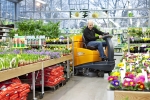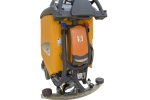Issue Date: 8 February 2012
Ref: DIV11/42
DON’T SLIP UP WITH FLOOR CARE THIS WINTER
The onset of bad weather in winter always raises the prospect of wet and dirty floors that increase the risk of the slips and trips which cause so many of the reportable accidents and injuries in the workplace and public spaces. Nobody likes to think about these accidents but when they occur they can cause inconvenience, suffering and - at worst - serious injuries for the person involved. This leads to disruption for the people responsible for the building and can also result in lengthy and costly legal problems for the people responsible for the building. The challenge facing building operators, service contractors and suppliers is how to reduce the risk, and hence number, of these accidents.
This is no insignificant problem. New figures from the HSE (for the year 2010/11) show that slips and trips on wet surfaces account for 10015 “serious” and “over three day” reportable accidents. The majority of these are in service industries, such as cleaning and building care. The HSE says that slips and trips are the most common cause of major injuries at work. It also says that slips and trips account for 50 per cent of all reported accidents to members of the public that happen in workplaces. The total cost to employers is £512 million and a further £133 million is spent by the health service in treating the injuries. These figures are improving, year on year, thanks to efforts by regulators and the various stakeholders but there is more to do.
Inevitably it falls on building operators and owners to take responsibility for mitigating the risk to their employees, guests and visitors. Keeping floors clean and dry is a good place to start. In most buildings the biggest problem is likely to be just inside the door because this is closest to wet outdoor areas and intensely used by people entering the building. Both factors increase the risk of an accident. Floors in these areas are typically hard surfaces such as vinyl, ceramic or stone which can be particularly susceptible to causing slips when they are wet or dirty. But they are easy to clean and maintain with the right equipment. For its part, Diversey (now part of Sealed Air) works with building owners and service contractors to advise on the most appropriate cleaning tools and products as well as the correct procedures to ensure the best possible combination of results, appearance and safety.
As an example, the company worked with the facilities management team responsible for one of London’s largest office complexes to prepare a specification for floor cleaning. The documentation devised by the company covered everything from an initial assessment of the potential for slips and trips through to appropriate procedures to ensure correct floor care. This was used by the cleaning contractors working on the site to ensure the floors performed within suitable parameters.
Larger buildings are likely to have access to scrubber driers that they or their cleaning services contractor will use for general floor maintenance. One of the big benefits of the scrubber drier is that it actively cleans the floor, picks up debris and removes the soiled water with a combination of squeegee and suction to leave the surface clean and dry. Ideally they should be used with an appropriate cleaning product because this ensures dirt is removed completely while helping to protect the flooring material for a long life of low maintenance. Some building owners, and even some cleaning contractors, erroneously believe that they can use their machines with water alone but this is a false economy. Leading suppliers, such as Diversey, offer a complete choice of products for use in the machine to achieve the best floor cleaning performance. Choosing the right product will save time, reduce any need for repeat cleaning and minimise costs.
For example, Diversey recently helped a hotel company revitalise a floor in its reception area. The limestone floor has been sealed inappropriately some years ago when new and was looking dirty and unwelcoming to guests. The hotel had a limited budget but needed an effective remedy. After assessing the floor conditions Diversey recommended the correct stripper to remove the old sealant from the floor using one of its scrubber driers and then applied a new finish to provide long-lasting protection with easy maintenance and reduced dust formation.
Scrubber driers come in all shapes and sizes, with the smallest no bigger than an upright domestic vacuum cleaner and the largest the size of a small car for cleaning the largest floors in places like hospitals, supermarkets and shopping centres. There is probably a size suited to every application but it is important to match the machine, in terms of size and performance, to the job in hand for it to be economical and effective. Battery powered machines offer the convenience of total independence from local power sockets with the added advantage of having no trailing power cables although the smaller machines tend to be mains powered for speed of use and convenience. With all machines the objective should be to leave the floor dry, or almost dry, so that it can be walked on as soon as possible.
Not all scrubber driers are the same so anyone in a position to choose their machine should look out for various features. It should be a given that the machine will clean the floor. However, the ability to clean and dry the floor will depend on the design of the brushes, squeegees and suction or pickup mechanism. The design of the squeegee and pick up is critical. The larger walk-behind and ride-on machines in the TASKI by Diversey range, for example, have a unique and patented W-shaped squeegee optimised for removing water and cleaning solution. Direct suction from the pick-up mechanism to the collecting tank optimises performance and reduces the risk of blockages caused by small pieces of debris. The result is that these machines routinely remove 99 per cent of the water or solution from the floor in a single pass.
In smaller buildings an alternative solution is to use a mopping system. Its advantage is simplicity and convenience but anyone still using the traditional mop and bucket should really think again. At best these will leave the floor wet. At worst, and this is perhaps more common, they spread as much dirt as they remove. Both instances might actually increase the risk of slips. The latest modern mopping systems are far better at cleaning, more economical and offer many sustainability benefits. Systems such as Diversey’s Versamop are ergonomically designed for ease of use and incorporate an integrated container that will dispense a controlled amount of cleaning solution onto the floor. This saves time and reduces wastage and, just as important, ensures that cleaning performance is optimised, all of which supports improved sustainability and cost control. Systems like these are ideal for frequent and quick cleaning of high traffic areas because they are convenient and easy to use. They can typically be used with reusable or disposable mopping pads to suit the specific application.
For the ultimate in floorcare some operators go even further and utilise reusable ultra microfibre systems, such as the TASKI Standard range, which allow them to clean floors and other hard surfaces without chemicals. This can promote even better productivity, sustainability and overall lifetime cost control.
Whichever method of floorcare is employed it is important to make sure that cleaning is done regularly throughout the day to remove the build up of dirt that can increase the risk of slips and trips. It is also vital to clean up puddles or patches of water as quickly as possible as these often present the biggest risk of all. Reputable cleaning suppliers will be able to work with end users to identify the most appropriate products, tools and processes and provide advice on the best ways to keep a building in safe and tip-top condition.


